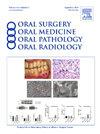DNA胞嘧啶脱氨酶APOBEC3B和化学致癌物4NQO协同作用,在体内加剧口腔肿瘤的发生
IF 1.9
3区 医学
Q2 DENTISTRY, ORAL SURGERY & MEDICINE
Oral Surgery Oral Medicine Oral Pathology Oral Radiology
Pub Date : 2025-07-21
DOI:10.1016/j.oooo.2025.04.083
引用次数: 0
摘要
apobec3相关的突变特征在许多人类恶性肿瘤的突变景观中占主导地位。其中一种酶,APOBEC3B (A3B),将DNA胞嘧啶转化为尿嘧啶(C-to-U),这些尿嘧啶在TC基序中以C-to-T/-G碱基取代的形式永生化。口腔和口咽鳞状细胞癌(SCCs)表现出A3B mRNA/蛋白水平升高和APOBEC3特征突变的高比例。最近,我们报道了一种表达肿瘤样水平的人类A3B的小鼠模型。在这里,我们展示了内源性A3B如何与外源性致癌物4NQO结合,促进体内口腔肿瘤的发生。材料与方法构建表达活性人A3B (N = 23)的8周龄工程C57BL/6J小鼠,用4NQO (50 μg/mL,饮水中)处理16周。动物恢复正常饮水(8周),第32周处死。野生型C57BL/6小鼠(N = 22)和表达催化无活性A3B变体(A3BE255A, N = 20)的小鼠作为对照。取舌和食管进行组织病理学分析。免疫组化法证实A3B水平(α-A3B rabbit mAb, 5210-87-13;1:350溶解)。采用泊松回归模型分析各组间差异;P & lt;0.05认为显著。结果未处理的野生型和表达a3b的动物无病变。正如预期的那样,4NQO引起了口腔内和食管病变,包括鳞状乳头状瘤、乳头状瘤、非侵入性、高级别、上皮发育不良和SCCs。与野生型动物相比,A3B在小鼠中的活性表达促进了口腔和食管肿瘤的发生(3 vs 1.5个病变/动物;P = .019)。此外,A3B导致侵袭性SCCs发生频率增加2.2倍,主要发生在舌部(P = .026)。通过免疫组化,a3b表达动物的所有病变均表现出一致的强核阳性。值得注意的是,与活性A3B动物相比,A3BE255A小鼠的口腔肿瘤发生明显减弱(P = .007);A3BE255A小鼠的整体病变负担与野生型组相似(P = .362)。结论致突变酶A3B活性时,与4NQO协同作用,促进口腔肿瘤的发生,从而加重肿瘤负荷和癌变。本文章由计算机程序翻译,如有差异,请以英文原文为准。
The DNA cytosine deaminase APOBEC3B and the chemical carcinogen 4NQO synergize to exacerbate oral tumorigenesis in vivo
Introduction
The APOBEC3-related mutation signatures dominate the mutational landscape of numerous human malignancies. One of the enzymes responsible, APOBEC3B (A3B), converts DNA cytosines to uracils (C-to-U), which become immortalized as C-to-T/-G base substitutions in TC motifs. Oral and oropharyngeal squamous cell carcinomas (SCCs) show elevated A3B mRNA/protein levels and high proportion of APOBEC3 signature mutations. Recently, we reported a mouse model that expresses tumor-like levels of human A3B. Here, we show how endogenous A3B may combine with the exogenous carcinogen 4NQO to promote oral tumorigenesis in vivo.
Materials and Methods
Engineered 8-week-old C57BL/6J mice constitutively expressing active human A3B (N = 23) were treated with 4NQO (50 μg/mL in drinking water) for 16 weeks. Animals were reverted to normal water (8 weeks) and sacrificed at the 32nd week. Wildtype C57BL/6 mice (N = 22) and mice expressing a catalytically inactive A3B variant (A3BE255A, N = 20) served as controls. Tongues and esophagi were harvested and analyzed histopathologically. A3B levels were confirmed by immunohistochemistry (α-A3B rabbit mAb, 5210-87-13; 1:350 dil.). Differences between groups were analyzed using Poisson regression models; P < .05 considered significant.
Results
Nontreated wildtype and A3B-expressing animals presented no lesions. As anticipated, 4NQO caused intraoral and esophageal lesions ranging from squamous papillomas to papillary, noninvasive, high-grade, epithelial dysplasias, and SCCs. Active A3B expression in mice promoted oral and esophageal tumorigenesis compared to wild-type animals (3 vs 1.5 lesions/animal; P = .019). Furthermore, A3B caused a 2.2-fold increase in the frequency of invasive SCCs, predominantly of the tongue (P = .026). By immunohistochemistry, all lesions in A3B-expressing animals showed uniformly strong, nuclear positivity. Notably, oral tumorigenesis was substantially attenuated in A3BE255A mice compared to active A3B animals (P = .007); A3BE255A mice featured overall lesional burden similar to the wildtype group (P = .362).
Conclusions
When active, the mutagenic enzyme A3B functions synergistically with 4NQO to promote oral neoplasia, thus exacerbating tumor load and carcinogenesis.
求助全文
通过发布文献求助,成功后即可免费获取论文全文。
去求助
来源期刊

Oral Surgery Oral Medicine Oral Pathology Oral Radiology
DENTISTRY, ORAL SURGERY & MEDICINE-
CiteScore
3.80
自引率
6.90%
发文量
1217
审稿时长
2-4 weeks
期刊介绍:
Oral Surgery, Oral Medicine, Oral Pathology and Oral Radiology is required reading for anyone in the fields of oral surgery, oral medicine, oral pathology, oral radiology or advanced general practice dentistry. It is the only major dental journal that provides a practical and complete overview of the medical and surgical techniques of dental practice in four areas. Topics covered include such current issues as dental implants, treatment of HIV-infected patients, and evaluation and treatment of TMJ disorders. The official publication for nine societies, the Journal is recommended for initial purchase in the Brandon Hill study, Selected List of Books and Journals for the Small Medical Library.
 求助内容:
求助内容: 应助结果提醒方式:
应助结果提醒方式:


